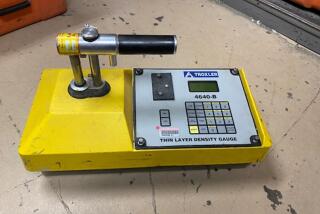The Cutting Edge: COMPUTERS/TECHNOLOGY/INNOVATION : Pocket Radar Hazard-Avoidance System Zeros In on the Marketplace : Technology: The device designed by Lawrence Livermore is expected to be big business for the lab.
- Share via
If you had your own personal radar device, one that you could carry around in your pocket or attach to your child’s crib or implant in the fender of your automobile, you would suddenly enjoy advanced warning about many of life’s day-to-day hazards.
This sort of hazard-avoidance is not the kind of thing scientists at Lawrence Livermore National Laboratory generally worry about. But one of the lab’s military research projects has led to the development of a tiny, battery-operated, motion-sensing radar that costs only $10--and the device will soon begin appearing in everything from automobiles to burglar alarms.
Known as the micropower impulse radar, or MIR, the device fits on a 1 1/2-inch circuit board, and can run on a pair of AA batteries for 8 years. The lab has already sold about 30 licenses for the technology, and its inventor, Livermore electronics engineer Tom McEwan, predicts that MIR will be “licensed more than any other thing has ever been licensed” at the lab.
Like all radars, the MIR device sends out radio waves and then “listens” for their reflections, thus determining the location and movement of objects that the radio waves strike. But the MIR sends out short wavelength signals very rapidly, and spreads the signals across a broad swath of the radio spectrum. The result is a radar that is highly accurate at short range.
“We’ve seen a lot of radar devices, but this is the first that’s this small and inexpensive with such robust features,” says Adi Lieberman, director of corporate development at Amerigon, a Burbank-based company that develops high-tech features for cars.
Amerigon, the first licensee, will use the radar for automobile safety devices. Implanted in taillights, the radar can be activated by the turn signal to let a driver know if a vehicle is in his or her blind spot. Warning systems for backing up and parking are also in the works and are expected to be available in 1997 or 1998.
Lieberman says that the radar works in all environmental conditions, performs well even when covered with mud and dirt, and is barely susceptible to interference from other radar systems. “You could have 10 cars with this type of radar next to each other on the highway and the radar’s effectiveness wouldn’t be compromised,” Lieberman says.
Indeed, the MIR potentially has big advantages over detection systems that use sound waves or infrared light largely because the radar is not subject to interference from heat or noise. And the short wavelengths mean it can penetrate many types of material and thus can be programmed to “see” through objects.
Other possible applications for the radar include enhancing traditional electrocardiograms by making it possible for doctors to see an accurate, three-dimensional screen image of the heart without injecting radioactive tracers into their patients. Companies can use it to build elevator doors that do not close on people, space heaters that turn off automatically when a child comes too close, and burglar alarm systems that can be concealed so well no thief could ever detect them.
McEwan came up with the idea for the MIR laser when he was building sampling devices to measure impulses from nuclear fusion reactions. And though it took a little time for the lab to exploit the commercial opportunities, McEwan says important benefits are being developed.
“Had I developed this in a private industry laboratory--for instance, for a burglar alarm manufacturer--its application would have been limited to that field,” McEwan says. “But it takes a national laboratory and an intellectual environment with people from different disciplines interacting to fully develop a discovery and its applications.”
More to Read
Inside the business of entertainment
The Wide Shot brings you news, analysis and insights on everything from streaming wars to production — and what it all means for the future.
You may occasionally receive promotional content from the Los Angeles Times.








